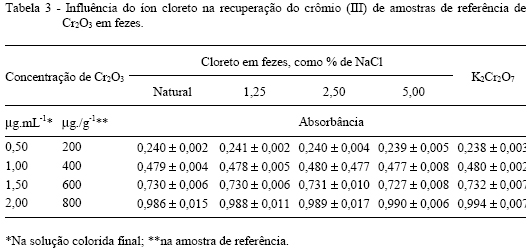This work aims at adjusting the spectrophotometric method of 1,5-diphenylcarbazide for the determination of chromium in feces, as a biological marker. Factors that could interfere with the transformation of chromium (III) into chromium (VI) were tested, as the metal recovery, the sample amount, the amount and the order of use of the oxidant acids of the wet digestion, digestion temperature and digestion time, loss of chromium by volatilization as chromyl chlorid. However the interference of these factors were not statistically determined. In the adjusted method, the sample is classically digested by nitric/perchloric acid mixture leading to the oxidation of chromium (III) to chromium (VI), and an aliquot of the diluted extract is used for reaction with 1,5-diphenylcarbazide; absorbance was measured at 550nm, using 1cm path length optical cuvettes. Potassium dichromate was used as a standard substance to obtain the standard curve ranging from 0.25mg.mL-1 to 2.5mg.mL-1 of Cr2O3 (1mg Cr2O3 º 1.9355mg K2Cr2O7).
chromium (III) oxide; biological marker; spectrophotometric determination; feces





